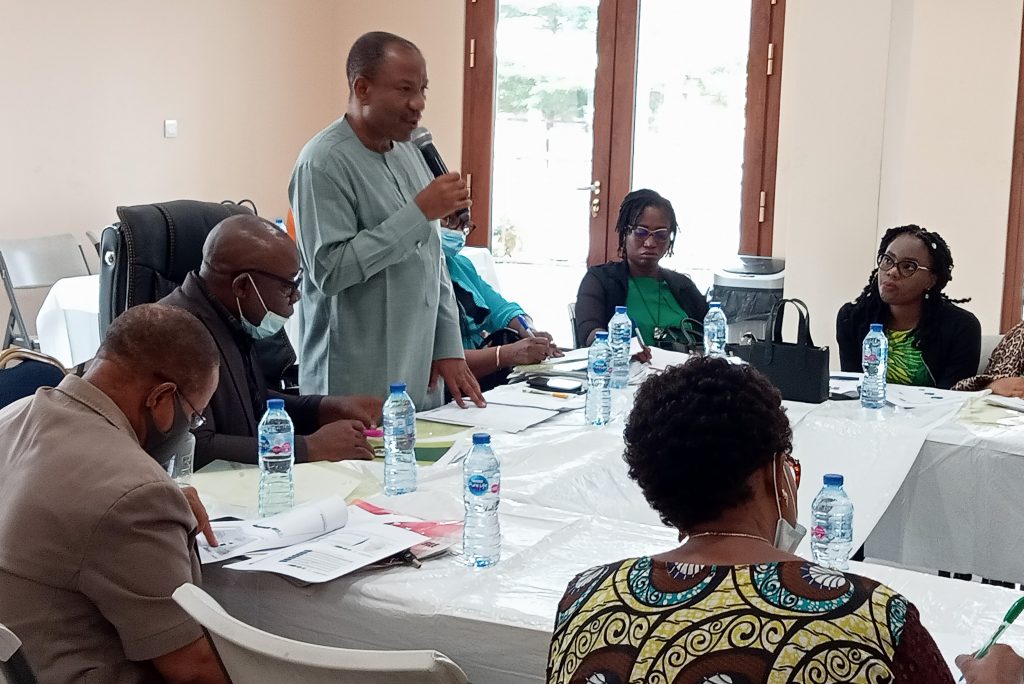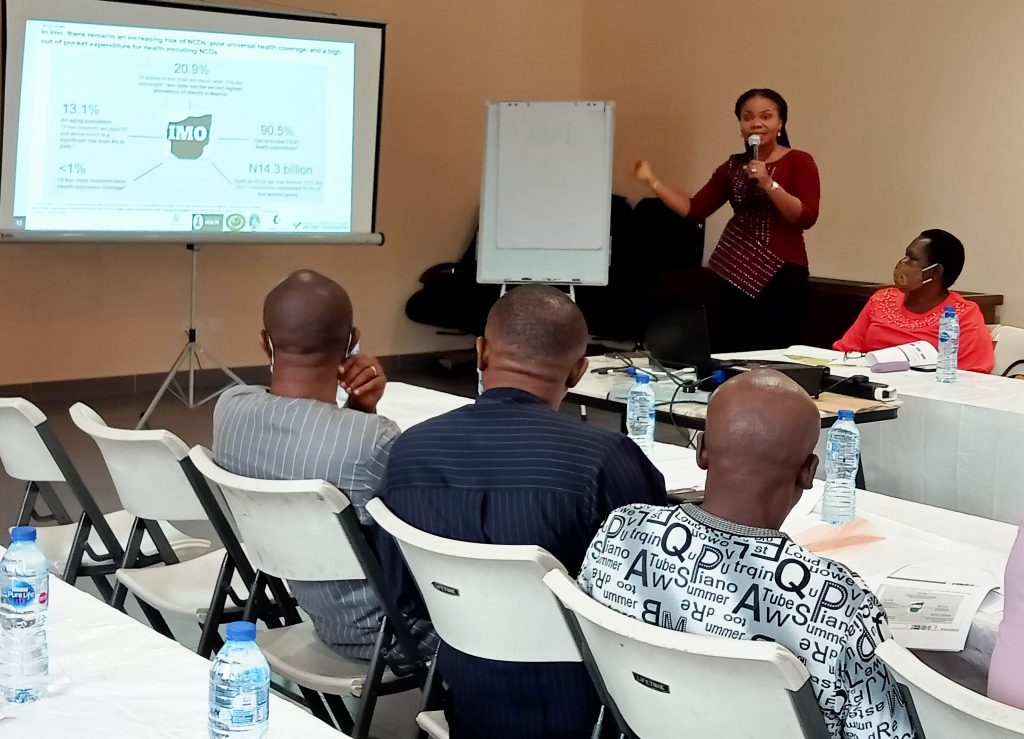Stakeholders Review Progress on Combating Non-Communicable Diseases in Imo State
Introduction
Globally, Non-Communicable Diseases (NCDs) are the leading causes of adult mortality[i]. In 2019, more than 19 million people were living with Diabetes Mellitus (DM) in Africa, with about three in every five living with undiagnosed diabetes[ii]. Similarly, the prevalence of hypertension in Africa has been estimated to be 27%. In Nigeria, the World Health Organization estimates that 29% of all adult mortalities are due to NCDs[iii]. Currently, Nigeria contributes the second-highest number of persons living with DM in Africa (only second to South Africa) with 2.7 million adults living with diabetes with a 3% prevalence in 2019[iii]. A nationwide survey in 2017 showed a hypertension prevalence of 38.1% (39.2% in the urban region and 37.5 % in the rural areas)[iv].

In Imo State, it is unclear what the burden of diabetes and hypertension are, as there are no current state-wide surveys. However, since 2018, the World Diabetes Foundation (WDF) has funded a Diabetes Awareness and Care (DAC) project, which is a two-year initiative led by the Federal Ministry of Health (FMoH) in collaboration with Health Strategy and Delivery Foundation (HSDF) to improve diabetes awareness, access to care, and availability of data in the FCT and Imo State by 2021. As part of the activities on this project, FMoH and HSDF conducted a baseline assessment in selected communities in Imo, where the prevalence of hypertension and diabetes were 31% and 3% respectively[v].
With the high Out-of-Pocket (OOP) health expenditure (90.5%) in the state[vi], a rapidly aging population (13%), and the current disease profile showing a transition from a predominantly communicable to non-communicable diseases[vii], there are considerable implications for the health system in Imo State. On this premise, the Department of Public Health, Imo State Ministry of Health partnered with HSDF to convene the second quarterly NCD policy meeting in the state.
Meeting Highlights
This meeting took place on 13 July, 2021 at Oxygen Hotel Owerri, Imo State. With the theme, Assessing the state’s performance in combating NCDs, the meeting aimed to:
- Review the trends and burden of diabetes and hypertension in the state
- Discuss Imo State’s commitment towards curbing the scourge of these diseases
- Discuss next steps based on the emerging evidence and insights from different interventions in the state
In attendance were 50 participants from various affiliations in the state, including the Honorable Commissioner for Health Dr BC Okorochukwu, Director of Public Health Dr Austin Okeji, Permanent Secretary of the Imo State Ministry of Health Lady Chux-Okoro MC, the Executive Secretary (ES) of the Imo State Health Insurance Agency Dr John Onyeokoro, the Non-Communicable Disease Desk Officer Dr Precious Inyanga, and Endocrinologist on the project Steering Committee Dr Anthony Anyanwu. Other participants were the World Health Organization State coordinator and managers from selected secondary and tertiary facilities in the state.
Following the welcome address by Dr BC Okorochukwu, stakeholders discussed the risk factors, burden, and trends of diabetes and hypertension in Imo State, citing data from the Nigeria Demographic Health Survey (NDHS), the DAC baseline assessment, and other data sources.


Guided by the Imo State Strategic Health Development Plan (2017–2022), they also discussed the State’s NCD prevention and control road map including targets to:
- Promote generation of evidence for decision-making for planning and implementation of NCD interventions
- Intensify advocacy, legislation, social mobilization, and behavior change communication for NCD prevention and control
- Promote healthy lifestyles and behaviors for the prevention of NCDs
- Expand access (geographic and financial, etc.) to NCD prevention, screening, control, and treatment services
- Improve the quality of life of those affected by NCDs
- Build capacity of health care providers, especially at lower levels (PHC), in prevention and screening for NCDs
- Promote demand for NCD services
Diabetes Awareness and Care (DAC) Project in Imo State
Thus far, on the DAC project, Imo State has sensitized 510,703 persons with diabetes and hypertension awareness messages and screened 46,726 persons for Type 2 DM. Using data and insights from the DAC project, the HSDF representative at the meeting highlighted challenges limiting the achievements of the Imo State’s NCD interventions and sustainability. These include workforce availability/retention, poor NCD awareness in non-project communities, access to essential medicines, and the need for community ownership of interventions.
Using the building blocks of the health system as a guide, participants proffered mitigation techniques to these challenges. These recommendations include:
- State-led sensitization and awareness activities using radio and TV programs to improve population awareness for NCDs
- Strengthening task-shifting in primary facilities and exploring innovative private partnerships for health workers to address the paucity of staffing challenges
- Establishment of community/facility drug revolving funds to ensure project sustainability post-implementation
- Expediting full implementation of the State Health Insurance Scheme to ensure improved access to care and reduce out-of-pocket expenditure for NCDs
- Ensuring the availability of minimum basic equipment (e.g. Stethoscope, Sphygmomanometer, Glucometer, etc.) at all PHCs
- Strengthening health governance and leadership at the ward/community level
HSDF will continue to collaborate effectively with the Imo State Ministry of Health to address complex health challenges impacting NCD prevention and care to ensure better health outcomes for NCDs in the State.

Director for Public Health, Imo State Ministry of Health Dr AU Okeji speaking during the policy meeting 
The Honorable Commissioner for Health, Dr BC Okorochukwu speaking during the policy meeting

A cross-section of participants at the policy meeting 
HSDF representative making a presentation
References
[i] World Health organization. Top 10 causes of death. Available at https://www.who.int/news-room/fact-sheets/detail/the-top-10-causes-of-death
[ii] https://www.idf.org/aboutdiabetes/what-is-diabetes/facts-figures.html
[iii] World Health Organization. Nigeria NCDs profile. Available at https://www.who.int/nmh/countries/nga_en.pdf?ua=1
[iv] https://globalheartjournal.com/articles/10.5334/gh.848/
[v] Diabetes Awareness and Care Project (2018). Baseline survey analysis.
[vi] Imo State Ministry of Health (2019). Estimating Household Healthcare Expenditures for Imo State
[vii] Imo State Ministry of Health (2019). Estimating Household Healthcare Expenditures for Imo State
Grants and Business Development Specialist
We are seeking a highly motivated and experienced Grants and Business Development Specialist to join our organization. The successful candidate will be responsible for identifying funding opportunities, developing grant proposals, and fostering partnerships with potential donors and stakeholders (regional and global). This role plays a vital part in securing funds and resources to support our organization’s mission and projects.
Apply NowPublic Health Consultant, Guinea
The consultant (working with the Accelerator team) will collect results from the tool, organize a meeting with stakeholders to discuss results from the tool, and produce a report on key findings and recommendations from the tool to be shared publicly.
Apply NowPublic Health Associate, Senegal
We are currently in search of an experienced Public Health professional in Senegal to work on the anticipated Nutrition Capacity Development and Financing Platform and provide technical assistance to elevate nutrition financing and strengthen local capacity to support these efforts. The Associate must be bilingual (English and French).
Apply Now